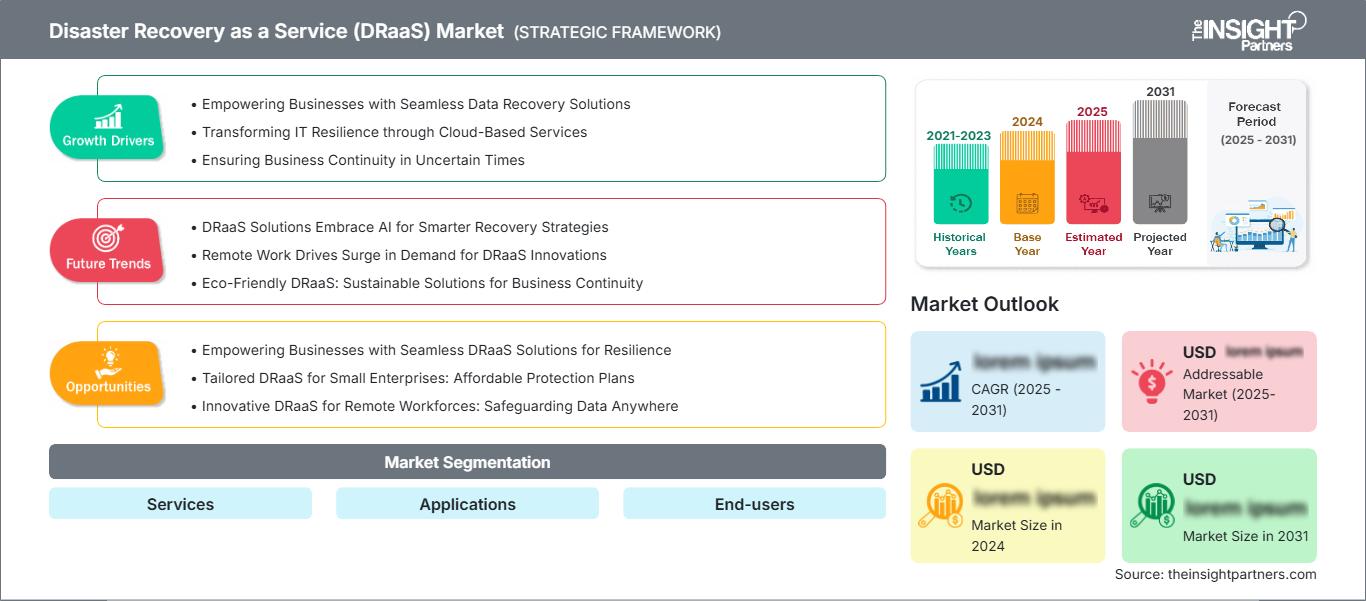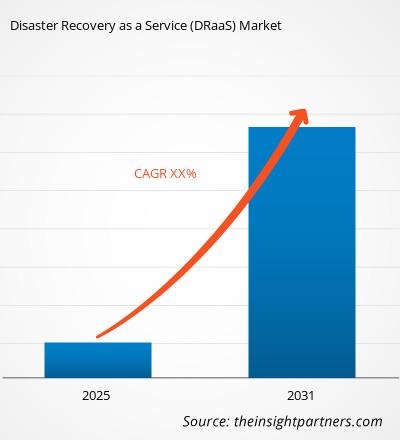预计到 2031 年,灾难恢复即服务 (DRAAS) 市场规模将达到 738.5 亿美元。预计该市场在 2025 年至 2031 年期间的复合年增长率将达到 23.9%。
该报告按服务类型进行分类,并进一步基于应用领域分析市场。此外,报告还按最终用户对市场进行了分析。报告对每个关键细分市场在全球、区域和国家层面都提供了全面的细分数据。
报告包含所有细分市场的市场规模和预测,数值以美元计。报告还提供了主要参与者当前市场地位的关键统计数据,以及对当前市场趋势和新兴机遇的深入见解。
报告目的
The Insight Partners发布的《灾难恢复即服务 (DRaaS) 市场报告》旨在描述当前市场格局和未来增长趋势,以及主要驱动因素、挑战和机遇。该报告将为各类业务利益相关者提供洞察,例如:
- 技术提供商/制造商:了解不断变化的市场动态和潜在的增长机会,从而能够做出明智的战略决策。
- 投资者:对市场增长率、市场财务预测以及整个价值链中存在的机会进行全面的趋势分析。
- 监管机构:监管市场政策和执法活动,旨在最大限度地减少滥用行为,维护投资者信任和信心,维护市场的诚信和稳定。
灾难恢复即服务 (DRaaS) 市场细分服务
应用程序
最终用户
您可以免费获得任何报告的定制服务,包括本报告的部分内容、国家/地区层面的分析、Excel 数据包,以及面向初创企业和高校的优惠折扣。
灾难恢复即服务 (DRaaS) 市场:战略洞察

- 获取本报告的主要市场趋势。这份免费样品将包含数据分析,内容涵盖市场趋势、估算和预测等。
灾难恢复即服务 (DRaaS) 市场增长驱动因素
- 为企业提供无缝数据恢复解决方案
- 通过云服务提升IT弹性
- 在不确定时期确保业务连续性
灾难恢复即服务 (DRaaS) 市场未来趋势
- 灾难恢复即服务 (DRaaS) 解决方案采用人工智能技术,打造更智能的恢复策略
- 远程办公推动灾难恢复即服务 (DRaaS) 创新需求激增
- 环保型灾难恢复即服务:可持续的业务连续性解决方案
灾难恢复即服务 (DRaaS) 市场机遇
- 为企业提供无缝的灾难恢复即服务 (DRaaS) 解决方案,增强其韧性
- 为小型企业量身定制的灾难恢复即服务 (DRaaS):经济实惠的保障计划
- 面向远程办公人员的创新型灾难恢复即服务 (DRaaS):随时随地保护数据安全
灾难恢复即服务 (DRaaS) 市场区域洞察
The Insight Partners 的分析师对预测期内影响灾难恢复即服务 (DRaaS) 市场的区域趋势和因素进行了详尽的阐述。本节还探讨了北美、欧洲、亚太地区、中东和非洲以及南美和中美洲等地区的灾难恢复即服务 (DRaaS) 市场细分和地域分布。
灾难恢复即服务 (DRaaS) 市场报告范围
| 报告属性 | 细节 |
|---|---|
| 2024年市场规模 | XX亿美元 |
| 到2031年市场规模 | 738.5亿美元 |
| 全球复合年增长率(2025-2031年) | 23.9% |
| 史料 | 2021-2023 |
| 预测期 | 2025-2031 |
| 涵盖部分 | 按服务按应用按最终用户 |
| 覆盖地区和国家 | 北美
|
| 市场领导者和主要公司简介 |
|
灾难恢复即服务 (DRaaS) 市场参与者密度:了解其对业务动态的影响
灾难恢复即服务 (DRaaS) 市场正快速增长,这主要得益于终端用户需求的不断增长,而终端用户需求的增长又源于消费者偏好的转变、技术的进步以及对产品优势认知的提高。随着需求的增长,企业不断拓展产品和服务,持续创新以满足消费者需求,并把握新兴趋势,这些都进一步推动了市场增长。

- 获取灾难恢复即服务 (DRaaS) 市场主要参与者概览
主要卖点
- 全面覆盖:该报告全面分析了灾难恢复即服务 (DRaaS) 市场的产品、服务、类型和最终用户,提供了一个全面的市场概览。
- 专家分析:该报告是根据行业专家和分析师的深入理解编制的。
- 最新信息:该报告涵盖了最新的信息和数据趋势,确保了其与业务的相关性。
- 定制选项:本报告可根据客户的具体需求进行定制,并能恰当地适应业务战略。
因此,这份关于灾难恢复即服务 (DRaaS) 市场的研究报告有助于深入了解和解读行业现状及增长前景。尽管其中可能存在一些合理的担忧,但总体而言,这份报告的优势远大于劣势。
- 历史分析(2 年)、基准年、预测(7 年)及复合年增长率
- PEST和SWOT分析
- 市场规模、价值/数量 - 全球、区域、国家
- 行业和竞争格局
- Excel 数据集
近期报告
客户评价
购买理由
- 明智的决策
- 了解市场动态
- 竞争分析
- 客户洞察
- 市场预测
- 风险规避
- 战略规划
- 投资论证
- 识别新兴市场
- 优化营销策略
- 提升运营效率
- 顺应监管趋势




















 获取免费样品 - 灾难恢复即服务(DRaaS)市场
获取免费样品 - 灾难恢复即服务(DRaaS)市场